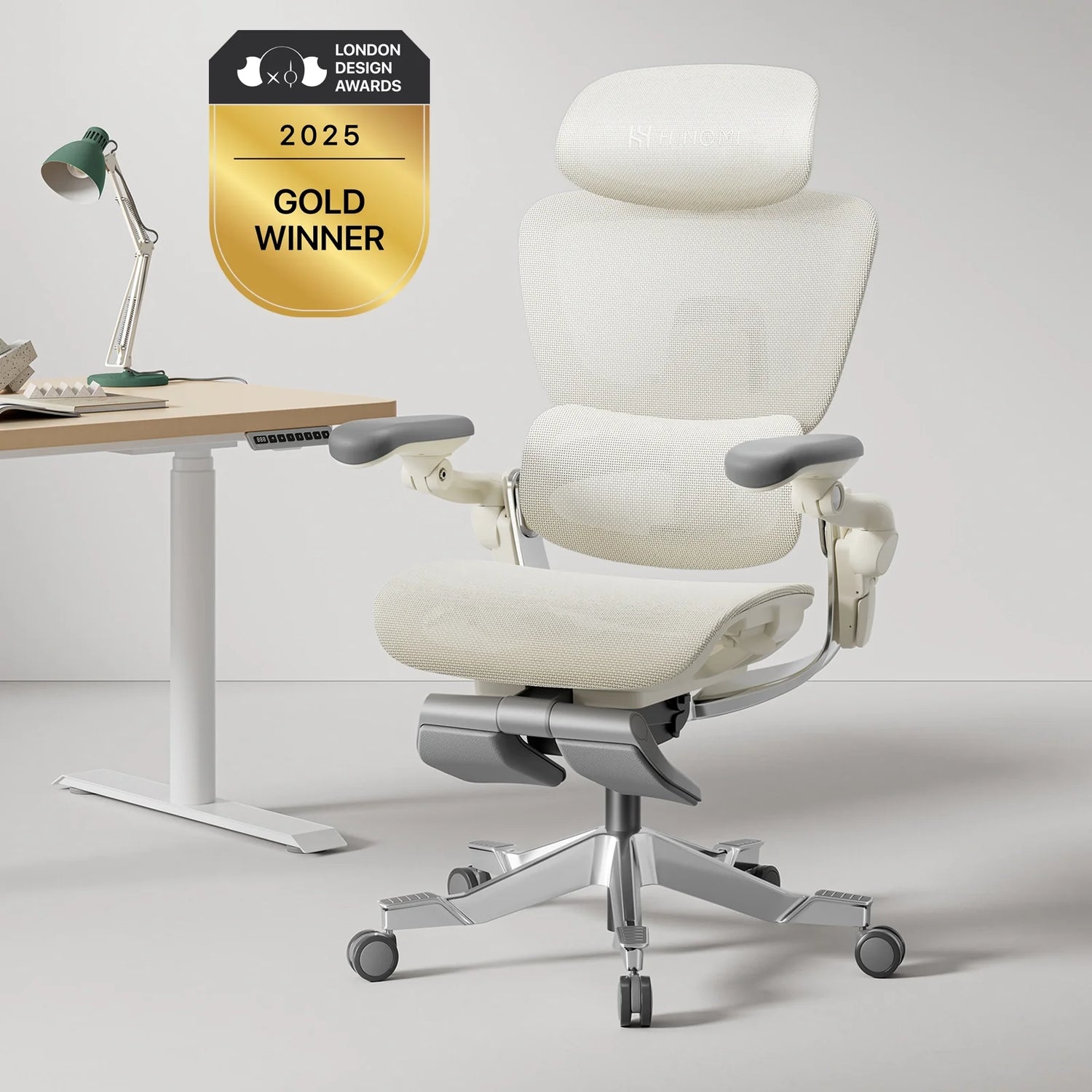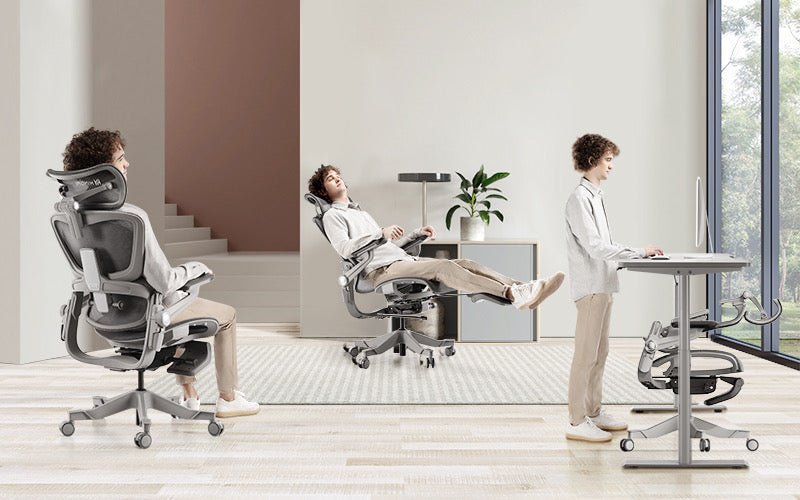Functionality is often prioritised when designing a workspace. But when you start noticing the more frequent back pains and the worsening slump on your shoulders, you will realise that ergonomics and posture should also play a critical role. Creating an ergonomic workstation helps you achieve better posture at your desk to stay productive while avoiding those aches and pains.
Wondering how to help your posture, especially if you spend hours behind your desk each day? Improving posture at work starts with investing in the right desk, chair, and other ergonomic products designed to support your body effectively.
Let’s explore some of the ways to improve posture and discover how to achieve ideal ergonomics in your office setup.
How to Achieve Correct Ergonomic Posture through Office Ergonomics

Achieving proper ergonomics and posture means finding the right balance between comfort and productivity.
The best posture at your desk can be achieved by maintaining the correct chair height, the proper table height, and the perfect placement of your laptop or monitor. Here are some guidelines that could help you figure out how to create an ergonomic workstation and what type of equipment you need:
- Keep your feet flat on the floor.
- Your legs should be comfortable enough to avoid frequently crossing your knees or ankles.
- There should be enough space between the chair and the back of your knees.
- Elbows should be angled in a way that releases tension from the shoulders.
- Forearms and knees should be as parallel to the floor as possible.
- Look straight ahead to avoid neck strain.
- Use a backrest that supports the natural curve of your spine.
With these guidelines in mind, it is important to choose the right desk and chair to help you maintain proper ergonomic posture.
How to Choose the Right Office Chair to Help with Posture

Choosing the best ergonomic chair for improving your posture at work can be easier if you know exactly what features to look for. Here are just some of the things you should look for when shopping for chairs to help support good posture.
Key Features of a Good Ergonomic Office Chair
- Adjustable height to help you customise the chair based on the length of your leg
- Ergonomic backrest that provides back support to help posture by following the spine’s natural curve and provides proper cervical, thoracic, and lumbar spine support
- Adjustable based on your sitting position, allowing you to lean forward, lean back or sit up straight as needed without sacrificing posture
- A headrest that follows the neck’s natural curve and offers enough support regardless of head position
- Adjustable armrest that allows you to keep your elbows at optimal angles regardless of sitting position, removing the strain and tension on the shoulders
- A leg rest that removes the strain on your legs when working, or when leaning back during breaks
For example, the H2 Pro Ergonomic chair is the perfect example of desk chairs that help with posture because it has all these features that help balance comfort and functionality. It can also be fully customised to fit your body shape and height perfectly.
An ergonomic office chair does not just give you an office chair to help with posture; it also sets you up for success as you focus more and become more productive. Office chairs that are designed for ergonomic sitting posture remove the tension on your body that distracts you and keeps you from working at full capacity.
If you are interested in learning more about the differences between an ergonomic chair and a regular office chair, check out our guide on ergonomic office chair vs regular office chair.
What are the Benefits of Using Office Chairs that Help Posture?

If you want to improve your workspace to maximise productivity, start by looking at chairs to help with posture. In addition to our previously published tips to create the best home office setup, here are some good reasons why an ergonomic chair should be your top priority:
- It improves your posture, which improves blood flow, supports your muscles, and gives you an overall positive disposition.
- It helps you avoid back pains, shoulder strain, neck stiffness, and other long-term effects of bad posture.
- It keeps you focused and alert, which, as a result, improves your productivity and creativity.
- Yes, improving your posture is at the root of many of the most common problems in the workplace. Bad posture affects both your physical and mental health, potentially impacting the quality of your work.
Establishing ideal work posture through the help of an ergonomic chair helps you deliver the best performance you are capable of.
Posture Improvement Tips with the Right Ergonomic Desk
 Once you have picked out a good chair, a good ergonomic desk should be next on your list. Does a standing desk help posture quality? Absolutely! A sit-stand desk allows you to adjust the desk height so that you can be productive regardless of if you are sitting or standing. Check out the section below to find out about the benefits of using a standing desk. Otherwise, our article “The Benefits of a Standing Desk” is a good resource of information to help you make an informed decision.
Once you have picked out a good chair, a good ergonomic desk should be next on your list. Does a standing desk help posture quality? Absolutely! A sit-stand desk allows you to adjust the desk height so that you can be productive regardless of if you are sitting or standing. Check out the section below to find out about the benefits of using a standing desk. Otherwise, our article “The Benefits of a Standing Desk” is a good resource of information to help you make an informed decision.
Key Features of an Ergonomic Standing Desk
To make sure you are maintaining ergonomic desk posture, it is best to check for the following features when browsing through different desks:
- Gives you a wide range of height adjustments so that your laptop or monitor are at eye level
- Allows you to position your keyboard in a way that helps you maintain optimal angles for your elbows
- Encourages alternating between sitting and standing throughout the workday to help with blood circulation and to keep you alert and focused
The S1 Ergonomic Office Standing Desk is a good example of a great work desk. Not only does it allow you to be productive while sitting down, but it also allows you to maintain that productivity even as you stand. You can learn more about how to choose the perfect standing desk by reading our standing desk guide.
What are the Benefits of Using a Sit-Stand Desk?

We often imagine ourselves sitting when we think of work. But work can also be done even while we are standing. In fact, people say that sitting is the new smoking – it can seriously impact our health, especially if done for hours at a time.
Using a sit-stand desk allows you to alternate between sitting and standing. This keeps you on your toes and provides a fresh whiff of energy every time you switch from one position to another.
Working while you are standing means that your biggest muscle groups are fully engaged, increasing the blood flow to your brain. This gives you the mental acuity you need, especially when working under tight deadlines.
Standing also keeps you in optimal health. The longer you stay seated in a day, the higher the risks of developing chronic health issues. Standing every so often helps you minimise the risks of developing cardiovascular problems and type 2 diabetes. And because your desk can be lifted to help you maintain ergonomic posture at desk height, you do not have to worry about your workflow being disrupted when you switch positions.
Other Ways to Improve Posture While Working

If you are wondering how to fix your posture and promote better posture at your desk, getting an ergonomic chair and desk is just the first step. There are several other tools available to support posture improvement while you work.
Using an adjustable monitor arm on your desk, for example, can help you ensure that your monitor is at eye level at all times. The default monitor stand usually does not give you a lot of options in terms of height adjustment, causing you to slightly bow down while you are working. This causes strain on your neck and shoulders.
The same thing can be said when you are using a laptop. In this case, you can use a laptop stand that lifts the screen to the ideal height.
Are your legs feeling strained or uncomfortable during long hours at your desk? Consider using the Ergonomic Footrest to promote better posture and reduce leg fatigue. This ergonomic footrest also acts as a stepper, to keep your feet supported and improve circulation. Elevating your legs and promoting movement keeps your body engaged and helps maintain proper ergonomic posture throughout the day.
Final Words on How to Help Your Posture with Ergonomic Office Furniture
It is the perfect time to invest in ergonomic office furniture that supports comfort, productivity, and health. By focusing on ways to improve posture and creating a thoughtful ergonomic workstation, you can avoid the long-term effects of bad posture.
Begin your journey toward a healthier, more productive work environment by investing in the right ergonomic office furniture to improve posture, paving the way for comfort, productivity, and overall well-being!

